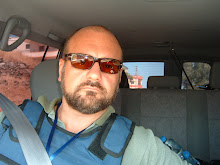 With this brief post I conclude my “Guatemala” security considerations. In the previous one I described how impunity and regular criminality affect dramatically security in the country. Here are some hints about the overall threats to the humanitarian organization I was in charge of, the organized crime and natural disasters (hurricanes and volcanoes).
With this brief post I conclude my “Guatemala” security considerations. In the previous one I described how impunity and regular criminality affect dramatically security in the country. Here are some hints about the overall threats to the humanitarian organization I was in charge of, the organized crime and natural disasters (hurricanes and volcanoes).The Threat:
There are currently no known specified threats against humanitarian staff and interests in Guatemala other than the general threats prevalent to all organizations and civilians in the country.
Crimes of opportunity such as car theft, abduction and muggings are ever present. In essence, the high level of criminality and little or no authority and no recourse to Police action in the rural areas is a serious threat to all visitors to, and agencies. As mentioned almost in all towns (mainly in the centers) the legality and police enforcement have not been fully restored.
Terrorist Action:
Currently there are no registered incidents of IED or VBED (Vehicle Borne Explosive Device) in Guatemala. However, the authorities have expressed concern and state that they have in the past monitored Muslim extremists travelling trough Guatemala. There are no officially identified terrorist groups by the Guatemalan Government, even though there are constant confrontation with groups such as the EXPAC (ex paramilitaries), which have in the past made their dissatisfaction known through violent means. Nonetheless the security system on site is constantly in touch with local authorities and the international community to ensure that there is an early warning system in place should the terrorist threat increase. However, the terrorist threat can be assessed as low in Guatemala.
Demonstration / political:
There is no obvious potential for politically motivated violence. The activities of the recent born International Commission Against Impunity in Guatemala (CICIG), mentioned in my previous article, backed by UN could increase the risk that international organizations could be targeted by organized crime. So far, the current threat of violent demonstration is assessed as low.
Road Accident:
Road travel in Guatemala is hazardous. Road conditions outside of town range from are generally good. The risk of a fatal accident appears to be high. The traffic is heavy in Guatemala City and the drivers have almost no discipline and respect of road regulations. Defensive driving techniques are a must for all drivers. The hazard presented by road travel is assessed as high.
Organized Criminal Activity:
This is the area of major concern in Guatemala. The Maras (youth gangs – see post dated August 16th) are of particular concern, since they are both involved with major drug operations, people smuggling syndicates and regional Mara turf wars. Additionally, they routinely control zones throughout the Capital, running extortion rackets, which include extensive involvement in the countries public transit system. As a result, it is highly recommended not to ride public buses or enter certain zones of Guatemala City and use only approved taxi companies suitable for official or personal travel. Lastly, organized crime groups have also been linked to kidnappings and “express kidnapping”, which take place frequently in Guatemala. Risk level is high.
Natural disasters/Force Majeur:
Hurricanes present a constant threat to Guatemala during the rainy season which has seen in 2005 (Hurricane Stan) approximately 2000 death. Weak government response, limited resources and a limited infrastructure all aggravate this problem. Guatemala is a geologically active country and earthquakes are also a constant concern, as well as flooding and regular power outages throughout the country. Guatemala has also 22 volcanoes, 4 of which are considered active. Volcanic activity, such as that of Fuego Volcano near Antigua in January 2003, and again in January 2006, has on occasion forced evacuations of nearby villages; the January-February 2000 activity of Pacaya Volcano near Guatemala City also briefly closed Guatemala City's international airport. The threat posed by the effects of an earthquake is assessed as high.
 Map of Major Volcanoes in Guatemala. Courtesy: intute.ac.uk
Map of Major Volcanoes in Guatemala. Courtesy: intute.ac.ukOBSERVATIONS AND RECOMMENDATIONS
· Crime is the biggest single threat to International Organizations in Guatemala. Sensible precautions can drastically reduce the probability of personnel becoming victims. Those most at risk are expatriates especially those recently arrived in country. Road traffic accidents are a serious problem. Sound vehicle maintenance and good driving practices will reduce the probability of accidents.
· Staff working in Guatemala City should keep the lowest profile possible while moving from/to the Capital. In this regard, it is recommendable to use magnetic logos for cars only for official missions or when it is strictly necessary in the field. This would reduce the visibility of the operators and mission and mitigate the risk.
Picture on top: Guatemalan Maras members arrested by special police - Courtesy: Noorlarnet.uoi.no




























